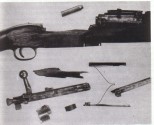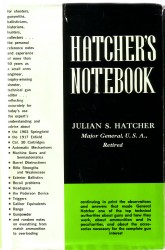Firearms Technical Trivia, July 2000:
 |
 |
 |
If you spend time talking to just about anyone who regularly shoots the U.S. Rifle, Caliber .30, M1903, or the "Springfield," the subject of "low numbered" Springfields will invariably arise. You'll be told that while these "low numbered" guns might have value as collector's pieces, they are not safe to shoot. Why this is, and what it means can only be explained through a careful analysis of the metallurgical history of the Springfield rifle.
From
the beginning of its production run in 1903, and up to 1927, the receiver
and bolt of the M1903 rifle were made from Springfield Armory Class C Steel,
later known as War Department (W.D) 1325, which had the following composition:
|
|
|
|
|
|
|
|
|
|
|
|
|
|
|
|
|
|
|
|
|
|
|
|
During the manufacturing process at Springfield Armory, a billet of steel was forged under a one ton drop hammer, hot trimmed, and while still hot, was given a single hammer blow while in the forging dies to straighten the forging. The forging was then placed in hot charcoal and allowed to cool very slowly, and then pickled to remove the scale. Then it was again placed under the drop hammer (cold this time), to bring it to the proper size. Once this was done, the prepared forging went to the machine shop, where it was transformed into a completed receiver. Once the machining processes were completed,
| the receiver was heated in bone to about 1500 degrees Fahrenheit. The receiver was kept at that temperature for four hours and then quenched in oil. At the Rock Island Arsenal, the receivers were made from the same steel until 1918, with the only difference being that they were heated in charred leather to 1475 - 1500 degrees fahrenheit and for three and a half to four hours and then quenched in oil. |
Forging: Forging is a manufacturing process where metal is plastically deformed under great pressure into high- strength parts know as forgings. The process is normally (but now always) performed hot by preheating the metal to a desired temperature. It is important to note that the forging process is entirely different from the casting (or foundry) process, in which the metal used is melted, then poured or injected into a die. Pickling: Pickling is the process of chemically removing oxides and scale from the surface of a metal by the action of water solutions of inorganic acids. Scale or Scaling: Oxidation (rust) of metal due to heat resulting in relatively heavy surface layers of oxide. |
As 1917 progressed, the Ordnance Department began to receive a number of Springfield rifles with significant damage that had occurred either during test firing or after a relatively small number of rounds have been fired. Typical damage was a demolished receiver and an intact barrel with the remnants of the fired case still in the chamber. The diagnosis was burnt steel. Burnt steel is that which has been heated too hot prior to quenching. The result is crystallization in the interior structure of the metal, creating a great weakness. However, a contributing factor was identified in the ammunition fired in the ruined guns. It was apparent that the case heads had been too soft when they left the factory, thus expanding and splitting at the moment of firing and letting high pressure gas into the receiver ring. As a result of these findings, half a dozen receivers were taken from the Springfield Armory production line at random and struck sharply with hammers. Several of them shattered.
One reason for the burnt steel was that the forging temperature was not being sufficiently controlled. Up to this time, metal temperature was determined by skilled furnace workers who would look into the furnace and gauge the metal's temperature by color. This "expertise" resulted in temperature variations of as much as 300 degrees due to the differences in ambient lighting on a bright sunny day and a cloudy one. This was corrected by installing pyrometers in the furnaces so that the heat treatment process could be consistently controlled by instrumentation. In the meanwhile, this potential for error had been magnified by the wartime increase in the labor force which resulted in less skilled personnel being employed in critical areas. The ultimate correction for this problem was found in an entirely new heat treatment process for the Springfield Armory Class C steel. This was the famous "double heat treatment" and was conducted as follows:
The billet was forged under the one ton drop hammer, hot trimmed, and then given another blow to straighten it. It was then allowed to cool in an open pan. Afterwards, it was pickled to remove the scale, cold trimmed, and brought to size cold under the drop hammer. The receiver forging was then annealed by packing it in charcoal and heating it to 1500 degrees for two hours and letting it cool in the furnace, after which it was pickled, inspected, and then sent to the machine shop. After machining the finished receiver was reheated in bone to a temperature of 1500 degrees for two and a half hours, and then quenched in oil. It was then reheated to 1300 degrees in a salt bath for five minutes and then again quenched in oil. Then it was drawn at 350 degrees in an oil bath and allowed to air cool. The finished receivers had a hardness ranging from 33 to 44 Rockwell C.
What were the differences and advantages offered by the new heat treatment? Under both treatments the treated components (receivers and bolts) were carburized so that the metal on and near the surface had a higher carbon content than the metal on the inside of the piece. In the single heat treat method, the receiver was simply heated above the hardening temperature and then quenched in oil. The result was that the receiver was hard all the way through. While the carburized surface was harder than the interior, the interior was still hard enough to be brittle under shock. The double heat treat process was based on the property that the higher a piece of steel's carbon content, the lower the temperature it must be heated to to make it harden when quenched. Also important is the nature of the carbon that exists within a piece of steel. If the carbon is in the form known as Pearlite, the steel will be soft. If it is in the form known as Martensite, it will be hard. Differing proportions of either will result in an intermediate hardness.
When steel is heated, there comes a point when Pearlite becomes Martensite - this is known as the decalescence point. If the steel is heated to this point and then cooled slowly, the recalescence point, that point where Martensite becomes Pearlite again. However, if steel that has reached the decalescence point is cooled suddenly by quenching it in oil or brine, then the Martensite will be trapped before it can revert back to Pearlite, and the resultant steel is very hard. In the double heat treat process, the initial heating to 1500 degrees and quenching hardens the metal through. Reheating to 1300 degrees draws the temper and softens the metal. This temperature is above the hardening point of the high carbon outside surface, but not hot enough to cause the lower carbon inside core to harden when quenched. When the piece at 1300 degrees is quenched, the receiver remains with an exterior surface that is very hard, with a softer, tough, and elastic interior core. The final heating to 350 degrees softens the outside layer slightly while adding to its toughness.
There is no known date when Springfield Armory converted entirely to the double heat treatment process. The change occurred between receivers number 750,000 and 780,000. It is known that receiver number 800,000, completed on February 20, 1918 and all subsequent receivers were double heat treated. Rock Island Arsenal records indicate that by May 11, 1918, and beginning with receiver number 285,507, the double heat treatment was adopted.
How strong were the double heat treated receivers? While this is obviously not true for every receiver, there do exist records of a double heat treated receiver and bolt that withstood a pressure of 133,000 psi. The case head melted away, and the stock, magazine, and extractor catastrophically disassembled, but the receiver held firm. After the First World War, and based on the success of the double heat treated receivers, methods were explored for re-treating the low numbered receivers. It was found that there was no practicable way to correct the deficiencies, and the low numbered receivers were withdrawn from service. LOW NUMBERED SPRINGFIELD AND ROCK ISLAND RECEIVERS SHOULD NOT BE FIRED WITH ANY AMMUNITION.
The double
heat treatment was continued at Springfield Armory up to receiver 1,275,766,
with all subsequent receivers made after April 1, 1927 being constructed
of Nickel Steel. Rock Island receivers made from number 319,921 were
also nickel steel.
Note: Data for this month's trivia page was gathered from:
Hatcher's Notebook, by Major General Julian S. Hatcher, United States Army, Retired, Stackpole Books, Harrisburg, Pennsylvania, 1966. ISBN 0-8117-0795-4)
Hatcher's
Notebook is
available from Amazon.com. Click on the image to order.
